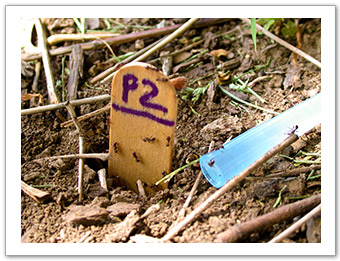Current Research Projects
As Director of the Industrial Affiliates Program at Purdue University, Dr. Buczkowski works closely with the chemical manufacturing industry to develop and test new products and technologies for the control of insect pests. Laboratory and field experiments are conducted to evaluate the efficacy of new chemistries, new formulations, delivery technologies, and application techniques with a focus on the management of urban and invasive pest ants. Other test insects include cockroaches, termites, and flies.
Horizontal transfer of insecticides in urban pests (ants and cockroaches)
 ^Emetophagy in the German cockroach: nymphs feed on insecticide-induced regurgitate
^Emetophagy in the German cockroach: nymphs feed on insecticide-induced regurgitate
Horizontal transfer of insecticides occurs when active ingredients contained within baits or liquid spray insecticides are passed among individuals within an insect population. Active members of a population, most often foraging adults, become exposed to an insecticide, return to the nest or an aggregation, and subsequently pass the insecticide to more sedentary members of the population. Depending on the insect taxon, various behavioral mechanisms including trophallaxis, necrophoresis, contact, coprophagy, necrophagy, and emetophagy may be involved. Current research focuses on: (1) behavioral and analytical studies to elucidate factors promoting horizontal transfer, (2) radiotracer studies to quantify insecticide transfer, (3) effect of active ingredient and delivery methods on horizontal transfer, and (4) improving bait formulation to maximize secondary and tertiary kill properties.
The effect of colony spatial structure on bait efficacy
 ^Polydomy in carpenter ants: a single colony nests in three separate trees
^Polydomy in carpenter ants: a single colony nests in three separate trees
Pest ants are often highly polydomous and comprise extremely large and spatially diffuse colonies. Current pest management strategies that rely on baits are often ineffective because baits are often misapplied and fail to reach all nests. To obtain better results with baits, we are currently investigating the effect of colony spatial structure (i.e. polydomy) on bait distribution. We are using the odorous house ant, Tapinoma sessile, as a model system to investigate how the spatial distribution of nests and foraging trails affects the distribution of bait in a large and a highly polydomous society. The primary goal of this research is to develop innovative integrated approaches (IPM) for the management of urban and invasive pest ants.
Ant nutritional ecology and bait optimization
 ^Pavement ants feed on a novel gel bait formulation
^Pavement ants feed on a novel gel bait formulation
Ants often exhibit clear feeding preferences which may affect bait uptake, distribution, and efficacy. The feeding preferences may shift depending on the season, colony nutritional needs, and local availability of food. To enhance existing ant management approaches and potentially develop novel tools for ant control we are currently investigating: (1) foraging habits of urban pest ants, (2) macronutrient preference and distribution studies, (3) competition at baits, and (4) seasonal food preferences.


